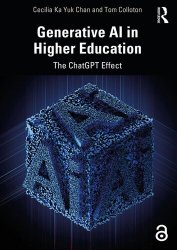Generative AI in Higher Education: The ChatGPT Effect
- Добавил: literator
- Дата: 11-03-2024, 20:55
- Комментариев: 0
 Название: Generative AI in Higher Education: The ChatGPT Effect
Название: Generative AI in Higher Education: The ChatGPT EffectАвтор: Cecilia Ka Yuk Chan, Tom Colloton
Издательство: Routledge
Год: 2024
Страниц: 287
Язык: английский
Формат: pdf (true)
Размер: 19.3 MB
Chan and Colloton’s book is one of the first to provide a comprehensive examination of the use and impact of ChatGPT and Generative AI (GenAI) in higher education.
Since November 2022, every conversation in higher education has involved ChatGPT and its impact on all aspects of teaching and learning. The book explores the necessity of AI literacy tailored to professional contexts, assess the strengths and weaknesses of incorporating ChatGPT in curriculum design, and delve into the transformation of assessment methods in the GenAI era. The authors introduce the Six Assessment Redesign Pivotal Strategies (SARPS) and an AI Assessment Integration Framework, encouraging a learner-centric assessment model. The necessity for well-crafted AI educational policies is explored, as well as a blueprint for policy formulation in academic institutions. Technical enthusiasts are catered to with a deep dive into the mechanics behind GenAI, from the history of neural networks to the latest advances and applications of GenAI technologies.
Opening with an introductory backdrop on Artificial Intelligence (AI), Big Data, the Internet of Things (IoT) and Generative AI (GenAI), the Chapter 1 offers readers foundational knowledge of these groundbreaking technologies and their specific applications within the educational settings. The spotlight is cast on ChatGPT by OpenAI, highlighting its potential as a revolutionary tool in higher education. A detailed breakdown of AI, from its inception in the 1950s to its current categorisations – Artificial Narrow Intelligence (ANI), Artificial General Intelligence (AGI), and Artificial Super Intelligence (ASI) – is provided. The chapter then delves into the significance of Big Data, IoT, and GenAI and their intrinsic characteristics, with a focused example on their implications for higher education. The chapter connects technological advancements with their practical implications in education, urging readers to consider the potential and pitfalls of integrating AI in the classroom.
AI is the simulation of human intelligence in machines that are designed to think and act like humans. AI involves the development of algorithms and models that enable computers to learn from data and make predictions or decisions based on said data. Advancements in electronics and computing hardware over recent years have allowed for huge leaps in the development of AI, enabling faster computing power, increased data and memory storage, and the creation of new algorithms such as Deep Learning.
Generative AI (GenAI) is a subset of Artificial Intelligence that involves creating new data or content. The term “generative” refers to the capability of AI to produce novel outputs rather than simply reproducing, categorising, processing, and analysing inputs. It can generate anything from text, images, audio, and videos, to natural-language text and even computer coding. The concept of GenAI is rooted in the field of Computer Science and Artificial Intelligence. One of the earliest references to such a technology can be found in the work of computer scientist John Hopfield in the 1980s, who proposed the idea of a “Hopfield network”, a type of computer neural network that could be trained to generate new patterns or sequences. The fields of Machine Learning and Artificial Neural Networks have evolved over time as researchers and practitioners worked to develop more sophisticated generative architecture and Deep Learning algorithms, including generative adversarial networks (GANs), variational autoencoders (VAEs), and transformer-based models (e.g. GPT-3 Generative Pretrained Transformer 3).
Generative modelling is a type of Machine Learning approach that focuses on creating new data that resembles the data it was trained on, based on the patterns and relationships learned from existing data. Machine Learning tasks using this approach are classified as unsupervised and semi-supervised Machine Learning tasks. The goal of the generative modelling approach is to create new examples that are similar to those it has seen before, which are representative of the underlying patterns and relationships in the data.
With an eye on the future of AI in education, this book will appeal to educators, students and scholars interested in the wider societal implications and the transformative role of GenAI in pedagogy and research.
Скачать Generative AI in Higher Education: The ChatGPT Effect
Внимание
Уважаемый посетитель, Вы зашли на сайт как незарегистрированный пользователь.
Мы рекомендуем Вам зарегистрироваться либо войти на сайт под своим именем.
Уважаемый посетитель, Вы зашли на сайт как незарегистрированный пользователь.
Мы рекомендуем Вам зарегистрироваться либо войти на сайт под своим именем.
Информация
Посетители, находящиеся в группе Гости, не могут оставлять комментарии к данной публикации.
Посетители, находящиеся в группе Гости, не могут оставлять комментарии к данной публикации.
